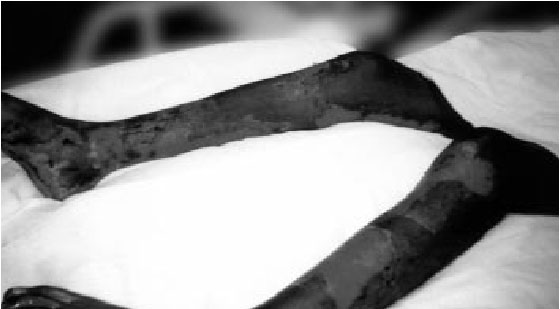
Burns resulting from “hosing” (Photo Courtesy of Augustine Medical.)
Augustine Medical has initiated a campaign against “hosing” failing to attach a blanket to the hose of a forced-air warming unit. We have undertaken this initiative to raise clinicians’ awareness of this dangerous practice, which occurs across the industry. When the blanket is omitted, heat exiting the hose is focused directly onto the patient. This practice can lead to traumatic thermal injury, sometimes third-degree burns. Some lawsuits have already been filed against hospitals and clinicians.
Forced-air warming systems are routinely used during surgery to keep patients warm and prevent complications from hypothermia. However, when perioperative practitioners use the system without attaching the blanket to the hose, the warm air flow is concentrated on one area of the patient’s bodyÐand burns have occurred. Hosing has led to first, second, and even third degree burns. Numerous cases have been documented in medical device reports to the FDA. In one particular case, the thermal injury progressed to a muscle necrosis so severe that it led to an above-the-knee amputation.
Warnings about the risk of improperly using forced-air warming systems are provided in operating manuals, service manuals, printed instructions, and on labels on the devices. ECRI published a Hazard Report specifically warning healthcare providers about the hazards of misusing forced-air warming systems. Yet, in spite of all these warnings, hosing still occurs.
Purpose of warming
Maintenance of normal body temperature (normothermia) is a realistic goal for surgical patients. Hypothermia can cause serious complications and has been associated with adverse effects on body systems and functions, including shivering, prolonged recovery time, altered drug metabolism, pressure sores, increased hospital stays, and even increased mortality and morbidity. Of course, not all patients will suffer these complications, but the more at risk the patient and the more significant the hypothermia, the greater the likelihood of adverse outcomes. Forced-air warming is an effective way to prevent and treat hypothermia in surgical patients. However, the improper use of these warming systems can cause serious harm to patients and create legal liability for the practitioner and institution. Patients have a right to expect safe care when entering a healthcare facility, and certainly not to endure injury as a result.
This campaign is designed to help educate clinicians about the dangers of hosing (also called “free hosing”). As the leading manufacturer of forced-air warming devices, Augustine Medical has undertaken this effort to ensure that these devices are properly used and that patients are not being harmed. The following materials are available to your facility by calling 800-733-7775 or going to www.stophosing.com and requesting anti-hosing materials:
- A brochure describing the dangers of the practice of hosing
- Posters that may be hung in your hospital’s lounge or other appropriate areas
- Labels that should be placed on the hoses of your Bair Hugger¨ warming devices
- Case studies about this subject
- An outcome studies summary
- ECRI report. For information about another manufacturer’s warming devices, please contact that manufacturer directly.
Thank you for taking the time to assure the safety of your patients.
Scott Augustine,
CEO Augustine Medical

